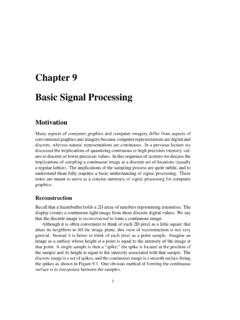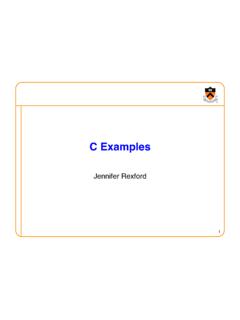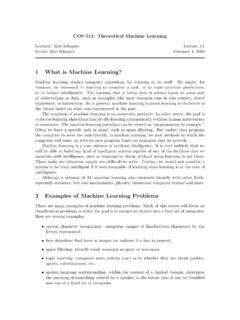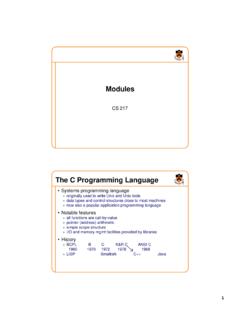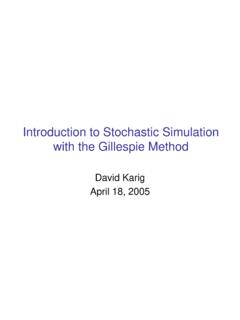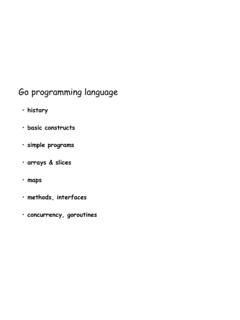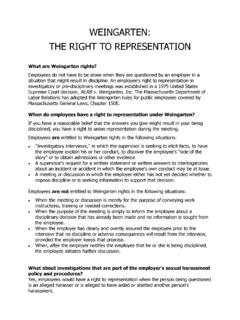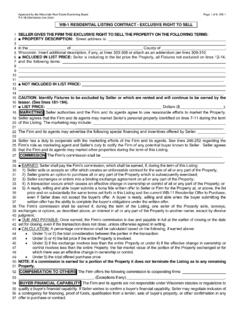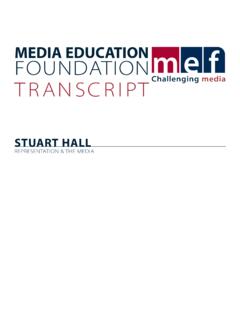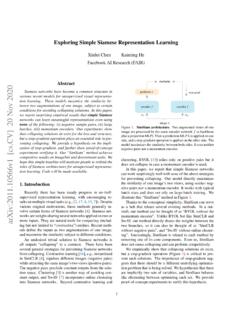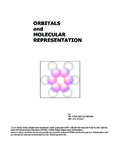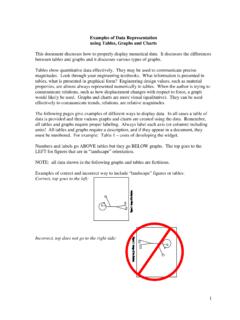Transcription of Number Systems and Number Representation
1 Number Systems and Number Representation 1 2 For Your Amusement Question: Why do computer programmers confuse Christmas and Halloween? Answer: Because 25 Dec = 31 Oct -- 3 Goals of this Lecture Help you learn (or refresh your memory) about: The binary, hexadecimal, and octal Number Systems Finite Representation of unsigned integers Finite Representation of signed integers Finite Representation of rational numbers (if time) Why? A power programmer must know Number Systems and data Representation to fully understand C s primitive data types Primitive values and the operations on them Agenda Number Systems Finite Representation of unsigned integers Finite Representation of signed integers Finite Representation of rational numbers (if time) 4 5 The Decimal Number System Name decem (Latin) => ten Characteristics Ten symbols 0 1 2 3 4 5 6 7 8 9 Positional 2945 2495 2945 = (2*103) + (9*102) + (4*101) + (5*100) (Most) people use the decimal Number system Why?
2 The Binary Number System Name binarius (Latin) => two Characteristics Two symbols 0 1 Positional 1010B 1100B Most (digital) computers use the binary Number system Terminology Bit: a binary digit Byte: (typically) 8 bits 6 Why? Decimal-Binary Equivalence 7 Decimal Binary 0 0 1 1 2 10 3 11 4 100 5 101 6 110 7 111 8 1000 9 1001 10 1010 11 1011 12 1100 13 1101 14 1110 15 1111 Decimal Binary 16 10000 17 10001 18 10010 19 10011 20 10100 21 10101 22 10110 23 10111 24 11000 25 11001 26 11010 27 11011 28 11100 29 11101 30 11110 31 11111 .. Decimal-Binary Conversion Binary to decimal: expand using positional notation 8 100101B = (1*25)+(0*24)+(0*23)+(1*22)+(0*21)+(1*20 ) = 32 + 0 + 0 + 4 + 0 + 1 = 37 Decimal-Binary Conversion Decimal to binary: do the reverse Determine largest power of 2 Number ; write template Fill in template 9 37 = (?)
3 *25)+(?*24)+(?*23)+(?*22)+(?*21)+(?*20) 37 = (1*25)+(0*24)+(0*23)+(1*22)+(0*21)+(1*20 ) -32 5 -4 1 100101B -1 0 Decimal-Binary Conversion Decimal to binary shortcut Repeatedly divide by 2, consider remainder 10 37 / 2 = 18 R 1 18 / 2 = 9 R 0 9 / 2 = 4 R 1 4 / 2 = 2 R 0 2 / 2 = 1 R 0 1 / 2 = 0 R 1 Read from bottom to top: 100101B The Hexadecimal Number System Name hexa (Greek) => six decem (Latin) => ten Characteristics Sixteen symbols 0 1 2 3 4 5 6 7 8 9 A B C D E F Positional A13DH 3DA1H Computer programmers often use the hexadecimal Number system 11 Why? Decimal-Hexadecimal Equivalence 12 Decimal Hex 0 0 1 1 2 2 3 3 4 4 5 5 6 6 7 7 8 8 9 9 10 A 11 B 12 C 13 D 14 E 15 F Decimal Hex 16 10 17 11 18 12 19 13 20 14 21 15 22 16 23 17 24 18 25 19 26 1A 27 1B 28 1C 29 1D 30 1E 31 1F Decimal Hex 32 20 33 21 34 22 35 23 36 24 37 25 38 26 39 27 40 28 41 29 42 2A 43 2B 44 2C 45 2D 46 2E 47 2F.
4 Decimal-Hexadecimal Conversion Hexadecimal to decimal: expand using positional notation Decimal to hexadecimal: use the shortcut 13 25H = (2*161) + (5*160) = 32 + 5 = 37 37 / 16 = 2 R 5 2 / 16 = 0 R 2 Read from bottom to top: 25H Binary-Hexadecimal Conversion Observation: 161 = 24 Every 1 hexadecimal digit corresponds to 4 binary digits Binary to hexadecimal Hexadecimal to binary 14 1010000100111101B A 1 3 DH Digit count in binary Number not a multiple of 4 => pad with zeros on left A 1 3 DH 1010000100111101B Discard leading zeros from binary Number if appropriate Is it clear why programmers often use hexadecimal? The Octal Number System Name octo (Latin) => eight Characteristics Eight symbols 0 1 2 3 4 5 6 7 Positional 1743O 7314O Computer programmers often use the octal Number system 15 Why? Decimal-Octal Equivalence 16 Decimal Octal 0 0 1 1 2 2 3 3 4 4 5 5 6 6 7 7 8 10 9 11 10 12 11 13 12 14 13 15 14 16 15 17 Decimal Octal 16 20 17 21 18 22 19 23 20 24 21 25 22 26 23 27 24 30 25 31 26 32 27 33 28 34 29 35 30 36 31 37 Decimal Octal 32 40 33 41 34 42 35 43 36 44 37 45 38 46 39 47 40 50 41 51 42 52 43 53 44 54 45 55 46 56 47 57.
5 Decimal-Octal Conversion Octal to decimal: expand using positional notation Decimal to octal: use the shortcut 17 37O = (3*81) + (7*80) = 24 + 7 = 31 31 / 8 = 3 R 7 3 / 8 = 0 R 3 Read from bottom to top: 37O Binary-Octal Conversion Observation: 81 = 23 Every 1 octal digit corresponds to 3 binary digits Binary to octal Octal to binary 18 001010000100111101B 1 2 0 4 7 5O Digit count in binary Number not a multiple of 3 => pad with zeros on left Discard leading zeros from binary Number if appropriate 1 2 0 4 7 5O 001010000100111101B Is it clear why programmers sometimes use octal? Agenda Number Systems Finite Representation of unsigned integers Finite Representation of signed integers Finite Representation of rational numbers (if time) 19 Unsigned Data Types: Java vs. C Java has type int Can represent signed integers C has type: signed int Can represent signed integers int Same as signed int unsigned int Can represent only unsigned integers To understand C, must consider Representation of both unsigned and signed integers 20 Representing Unsigned Integers Mathematics Range is 0 to Computer programming Range limited by computer s word size Word size is n bits => range is 0 to 2n 1 Exceed range => overflow Nobel computers with gcc217 n = 32, so range is 0 to 232 1 (4,294,967,295) Pretend computer n = 4, so range is 0 to 24 1 (15)
6 Hereafter, assume word size = 4 All points generalize to word size = 32, word size = n 21 Representing Unsigned Integers On pretend computer 22 Unsigned Integer Rep 0 0000 1 0001 2 0010 3 0011 4 0100 5 0101 6 0110 7 0111 8 1000 9 1001 10 1010 11 1011 12 1100 13 1101 14 1110 15 1111 Adding Unsigned Integers Addition Results are mod 24 23 11 7 0111B + 10 + 1010B -- ---- 1 10001B 1 3 0011B + 10 + 1010B -- ---- 13 1101B Start at right column Proceed leftward Carry 1 when necessary Beware of overflow How would you detect overflow programmatically? Subtracting Unsigned Integers Subtraction Results are mod 24 24 2 3 0011B - 10 - 1010B -- ---- 9 1001B 12 0202 10 1010B - 7 - 0111B -- ---- 3 0011B Start at right column Proceed leftward Borrow 2 when necessary Beware of overflow How would you detect overflow programmatically?
7 Shifting Unsigned Integers Bitwise right shift (>> in C): fill on left with zeros Bitwise left shift (<< in C): fill on right with zeros Results are mod 24 25 10 >> 1 => 5 10 >> 2 => 2 5 << 1 => 10 3 << 2 => 12 What is the effect arithmetically? (No fair looking ahead) What is the effect arithmetically? (No fair looking ahead) 1010B 0101B 1010B 0010B 0101B 1010B 0011B 1100B Other Operations on Unsigned Ints Bitwise NOT (~ in C) Flip each bit Bitwise AND (& in C) Logical AND corresponding bits 26 ~10 => 5 10 1010B & 7 & 0111B -- ---- 2 0010B Useful for setting selected bits to 0 1010B 0101B Other Operations on Unsigned Ints Bitwise OR: (| in C) Logical OR corresponding bits Bitwise exclusive OR (^ in C) Logical exclusive OR corresponding bits 27 10 1010B | 1 | 0001B -- ---- 11 1011B Useful for setting selected bits to 1 10 1010B ^ 10 ^ 1010B -- ---- 0 0000B x ^ x sets all bits to 0 Aside.
8 Using Bitwise Ops for Arith Can use <<, >>, and & to do some arithmetic efficiently x * 2y == x << y 3*4 = 3*22 = 3<<2 => 12 x / 2y == x >> y 13/4 = 13/22 = 13>>2 => 3 x % 2y == x & (2y-1) 13%4 = 13%22 = 13&(22-1) = 13&3 => 1 28 Fast way to multiply by a power of 2 Fast way to divide by a power of 2 Fast way to mod by a power of 2 13 1101B & 3 & 0011B -- ---- 1 0001B 29 Aside: Example C Program #include < > #include < > int main(void) { unsigned int n; unsigned int count; printf("Enter an unsigned integer: "); if (scanf("%u", &n) != 1) { fprintf(stderr, "Error: Expect unsigned int.\n"); exit(EXIT_FAILURE); } for (count = 0; n > 0; n = n >> 1) count += (n printf("%u\n", count); return 0; } What does it write? How could this be expressed more succinctly? Agenda Number Systems Finite Representation of unsigned integers Finite Representation of signed integers Finite Representation of rational numbers (if time) 30 Signed Magnitude 31 Integer Rep -7 1111 -6 1110 -5 1101 -4 1100 -3 1011 -2 1010 -1 1001 -0 1000 0 0000 1 0001 2 0010 3 0011 4 0100 5 0101 6 0110 7 0111 Definition High-order bit indicates sign 0 => positive 1 => negative Remaining bits indicate magnitude 1101B = -101B = -5 0101B = 101B = 5 Signed Magnitude (cont.))
9 32 Integer Rep -7 1111 -6 1110 -5 1101 -4 1100 -3 1011 -2 1010 -1 1001 -0 1000 0 0000 1 0001 2 0010 3 0011 4 0100 5 0101 6 0110 7 0111 Computing negative neg(x) = flip high order bit of x neg(0101B) = 1101B neg(1101B) = 0101B Pros and cons + easy for people to understand + symmetric - two reps of zero Ones Complement 33 Integer Rep -7 1000 -6 1001 -5 1010 -4 1011 -3 1100 -2 1101 -1 1110 -0 1111 0 0000 1 0001 2 0010 3 0011 4 0100 5 0101 6 0110 7 0111 Definition High-order bit has weight -7 1010B = (1*-7)+(0*4)+(1*2)+(0*1) = -5 0010B = (0*-7)+(0*4)+(1*2)+(0*1) = 2 Ones Complement (cont.) 34 Integer Rep -7 1000 -6 1001 -5 1010 -4 1011 -3 1100 -2 1101 -1 1110 -0 1111 0 0000 1 0001 2 0010 3 0011 4 0100 5 0101 6 0110 7 0111 Computing negative neg(x) = ~x neg(0101B) = 1010B neg(1010B) = 0101B Pros and cons + symmetric - two reps of zero Computing negative (alternative) neg(x) = 1111B - x neg(0101B) = 1111B 0101B = 1010B neg(1010B) = 1111B 1010B = 0101B Two s Complement 35 Integer Rep -8 1000 -7 1001 -6 1010 -5 1011 -4 1100 -3 1101 -2 1110 -1 1111 0 0000 1 0001 2 0010 3 0011 4 0100 5 0101 6 0110 7 0111 Definition High-order bit has weight -8 1010B = (1*-8)+(0*4)+(1*2)
10 +(0*1) = -6 0010B = (0*-8)+(0*4)+(1*2)+(0*1) = 2 Two s Complement (cont.) 36 Integer Rep -8 1000 -7 1001 -6 1010 -5 1011 -4 1100 -3 1101 -2 1110 -1 1111 0 0000 1 0001 2 0010 3 0011 4 0100 5 0101 6 0110 7 0111 Computing negative neg(x) = ~x + 1 neg(x) = onescomp(x) + 1 neg(0101B) = 1010B + 1 = 1011B neg(1011B) = 0100B + 1 = 0101B Pros and cons - not symmetric + one rep of zero Two s Complement (cont.) Almost all computers use two s complement to represent signed integers Why? Arithmetic is easy Will become clear soon Hereafter, assume two s complement Representation of signed integers 37 Adding Signed Integers 38 11 3 0011B + 3 + 0011B -- ---- 6 0110B 111 7 0111B + 1 + 0001B -- ---- -8 1000B pos + pos pos + pos (overflow) 1111 3 0011B + -1 + 1111B -- ---- 2 10010B pos + neg 11 -3 1101B + -2 + 1110B -- ---- -5 11011B neg + neg 1 1 -6 1010B + -5 + 1011B -- ---- 5 10101B neg + neg (overflow) How would you detect overflow programmatically?
